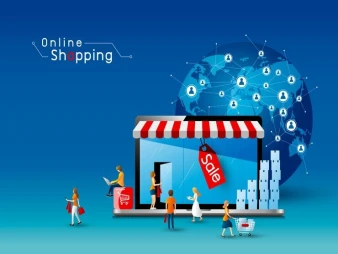Free support 24/7
Free support 24/7

Test marketing (or A/B marketing) is one of the powerful tools companies can use to improve the effectiveness of marketing campaigns and increase customer conversions. Test marketing aims to test the impact of specific factors on the target audience and measure the response to these factors. These factors can include changes in items such as the title, images, text, colors, page design, and even offers and discounts. By conducting beta testing, companies can gain valuable data that will help them make informed decisions to improve their marketing strategies. In this article, we'll look at how test marketing is used and the benefits it can bring to businesses.
Guiding strategic decisions: Experiential marketing provides companies with accurate data that helps them make strategic, evidence-based decisions. This data can be used to identify and invest in the most feasible trends.
Improving customer experience: By testing customer interaction with various factors, companies can identify factors that contribute to improving customer experience and making it more satisfying.
Save time and resources: Instead of relying on hunch and guesswork, companies can, based on actual data, make informed, accurate changes. This contributes to saving effort and resources.
Create copies: Create two copies of the ad element, and modify the factor you want to test.
Test application: Show both versions to a target audience. It is preferable to choose a large and diverse sample of the audience to ensure the accuracy of the results.
DATA COLLECTION AND ANALYSIS: After the public exposure period of both versions has ended, collect data on the performance of each version. This data may include click-through rate, conversion rate, and other important metrics.
Score Analysis: Analyze the data to understand which version performed better overall. This will help you identify factors that have positively impacted campaign performance.
Apply the results: Based on the results, adjust your marketing campaign to use the factors that impacted you positively. These changes can be in ad elements, target page, and target audience.
Continuous testing: Test marketing is not a one-time process. You should continue to run new tests on a regular basis to continually improve your marketing strategies.
Tips for getting the most out of test marketing
Check the differences: When running tests, make sure that the differences between the two versions are clear and tangible. This will make it easier to determine the difference in performance.
Respect for Statistics: You need to have a large and representative sample of your audience to get accurate statistical results.
Testing one factor at a time: Avoid changing several factors at the same time, as it is difficult to determine exactly which factor affects the results.
Experiment with multiple domains: Don't just test small changes. Try a large element modification experiment to test new hypotheses.
Optimize for results: Keep improving your strategies based on results, and keep looking for ways to improve your conversions and campaign performance.
Experimental marketing developments and modern technologies
With the advancement of technology and the development of digital means, new techniques for implementing experiential marketing have emerged, which have increased its strength and effectiveness. Here are some recent developments and technologies in this field:
1. Audience Segmentation and Personalization
Segment the audience into different categories and provide personalized messages that enhance customer engagement with campaigns. The interaction of different classes with particular messages can be experimented with to determine which methods are most effective for each class.
2. Using Artificial Intelligence (AI) and Machine Learning
Intelligent technologies such as artificial intelligence and machine learning quickly analyze data and identify patterns and trends. Intelligent systems can recommend potential changes based on data analysis.
3. Multivariate Testing
Instead of testing just one factor, the effect of several factors together on campaign performance can be tested. This allows understanding the interactions of different agents and determining the optimal combination.
4. Deep Analytics and Tracking Technologies
Deep analytics techniques can be used to extract deep insights from data and interactions, helping to identify and improve reasons behind specific performance.
5. Experimentation Platforms
Advanced experimental platforms have emerged that help companies implement experiments more effectively and easily. These platforms provide intuitive user interfaces and powerful analysis tools.
6. Virtual reality and augmented reality technology
The use of virtual reality and augmented reality technology can provide different interactive experiences for customers, which contributes to improving interaction with campaigns.
challenges and consideration
Despite the great benefits of test marketing, there are some challenges that need to be considered while implementing it:
1. Accuracy and Time: It may take time to fully collect and analyze data. ought to
The testing process is consistent and regular to obtain accurate results.
2. Technical Challenges: The technologies you use can face challenges such as issues with tracking and data fragmentation. You must ensure that you use reliable technical tools and platforms.
3. Balance between innovation and stability: Although experiments are important, some stability must be maintained in marketing campaigns. Highly repeated experiences may affect brand differentiation.
4. Reliance on correct data: It must be ensured that data is collected from reliable sources and analyzed accurately. Relying on inaccurate data may lead to wrong decisions.
5. Audience and context: The interaction of the target audience and the context in which they live must be taken into account. Audiences may react to different factors based on their different cultures and needs.
6. Variety and Continuous Change: Experiential marketing strategies require continually experimenting with different modifications. This requires respect for innovation and the ability to adapt to changes.
Tips for implementing test marketing successfully
Set Clear Goals: Before you start the trials, you should define the specific goals you want to achieve through the trials. Are you aiming to increase your click rate? Or improve conversion rate? Setting goals helps direct your efforts better.
Choosing the Right Factors to Test: Decide which factors you want to test based on your understanding of the audience's needs and campaign goals. These factors can be title, image, text, colors, widths, and more.
Respect the scientific process: Develop a systematic plan to carry out experiments. Start by identifying the factors and versions to test, apply the tests to a sample audience, and collect and analyze data thoroughly.
Interact with data logically: When analyzing results, try to be logical in your conclusion. Do not make inferential decisions based on results that are few or statistically uncertain.
Retain successful changes: If you're seeing positive results from certain experiences, implement those changes more broadly in your marketing campaigns.
Continuous testing: Don't just do one experiment. Keep running new tests constantly to improve your strategies and stay up to date with the latest developments.
Listen to customers: Connect with your audience and hear their feedback on the changes you've made. This feedback can guide you towards improvements that are more in line with your audience's needs.
1. eBay
eBay has used experiential marketing to improve ad pages on its platform. They experimented with simple changes to the design and layout of the pages, such as changing the colors of buttons and improving the arrangement of items. The results of the experiments showed a significant increase in conversion rates, which positively affected the user experience and increased sales.
2. Hotels.com
Hotels has conducted testing based on experiential marketing to improve conversion rates on their site. They experimented with changing the text of the call to action and presentation style. The results show a significant increase in conversion rates and increased revenue.
3. Google
Google used experiential marketing to improve the conversion rate of the Google Account login page. They experimented with changes to the design and colors of buttons and text. Test results show a significant increase in the conversion rates of the login page.
Impact of test marketing on the future
It is expected that the evolution of experiential marketing and its impact on the field of marketing will continue in the future. With modern technologies and continuous improvements, experiential marketing will have a greater role to play in improving marketing strategies and getting the most out of marketing efforts. Here are some predictions for how experiential marketing will impact the future:
1. Increase personalization and personal experience:
As technology continues to advance, companies will be able to more deeply personalize customer experiences. Machine learning and artificial intelligence technologies will be used to accurately analyze customer behavior and provide unique and personalized experiences tailored to each individual's needs.
2. Real-time experiential marketing:
As rapid analytics techniques advance, real-time heuristic experiments will become more prevalent. Companies will be able to update and improve their marketing campaigns as they are being implemented based on the data that is immediately available.
3. Reliance on data and deep analysis:
Deep analytics and big data are expected to be increasingly used in experiential marketing. These techniques will help analyze the behavior pattern and extract deep insights to direct marketing efforts.
4. Wider applications in different sectors:
Experiential marketing techniques will be adopted in a variety of industries and sectors. Experiential marketing will not be limited to the digital field only, but will also be applied in areas such as retail, industry, healthcare, and others.
5. Evolution of Experimental Experimental Platforms and Tools:
Experiential marketing platforms and tools are expected to continue to evolve and improve. More intuitive user interfaces and better analytical power will be developed to facilitate the implementation and management of test marketing operations.
Continuing the experimental marketing process, they contribute to building stronger relationships with customers and achieving a competitive advantage in a diverse and competitive market.
It is important to remember that experiential marketing is not just a simple experimental process, but rather a scientific approach that relies on data and analytics to make more targeted and successful marketing decisions. Businesses must invest in data analytics architecture and machine learning techniques to maximize the benefits of experiential marketing.
As technology evolves and market complexities increase, experiential marketing will continue to be a vital tool to improve marketing operations and drive better results. By providing the opportunity to continually discover and improve the best marketing approaches, experiential marketing will contribute to my achievement
s sustainable success, increasing customer satisfaction and achieving business goals effectively.
Experiential marketing will contribute to shaping the future of marketing strategies through:
1. Sustainable interaction with customers:
By using continuous experimentation, companies will be able to understand and adapt to changing customer needs. This will lead to continuously providing interactive and improved customer experiences, which will increase their satisfaction and loyalty.
2. Adaptation to Changes in the Market:
Since markets and trends change quickly, experiential marketing will be a powerful tool for adapting to these changes. By testing new ideas and better responding to current trends, companies can stay on top of what's going on in the market.
3. Build unique and innovative experiences:
By using experiential marketing, companies can offer customers unique and innovative experiences. This will attract the attention of the public and contribute to distinguishing the brand from its competitors.
4. Increase success and reduce risk:
Rather than relying on guesswork, experiential marketing provides clear evidence that allows companies to make informed decisions. This contributes to reducing risks and increasing chances of success in marketing campaigns.
5. Continuous Improvement and Innovation:
Experiential marketing encourages continuous improvement and innovation, as companies can build on results and apply successful experiences to develop new and innovative strategies.
6. Enhancing interaction between departments within the company:
Because of its data- and results-informed nature, experiential marketing encourages interaction and collaboration between various departments of a company, such as marketing, analysis, and product development.
In conclusion, experiential marketing remains a pivotal tool for improving the effectiveness of marketing campaigns and achieving business goals. By leveraging data and analytics and employing advanced technologies, companies will continue to develop their strategies and achieve sustainable success in the competitive world of marketing.

Flash sales are not just a temporary marketing tool. They are a smart tool to quickly drive sales and increase engagement in your store

تعرف على الطريقة الذكية اللي تخليك تستفيد من تجارب عملاءك السابقين في تسويق منتجاتك الجديدة وزيادة المبيعات
You can create your store easily